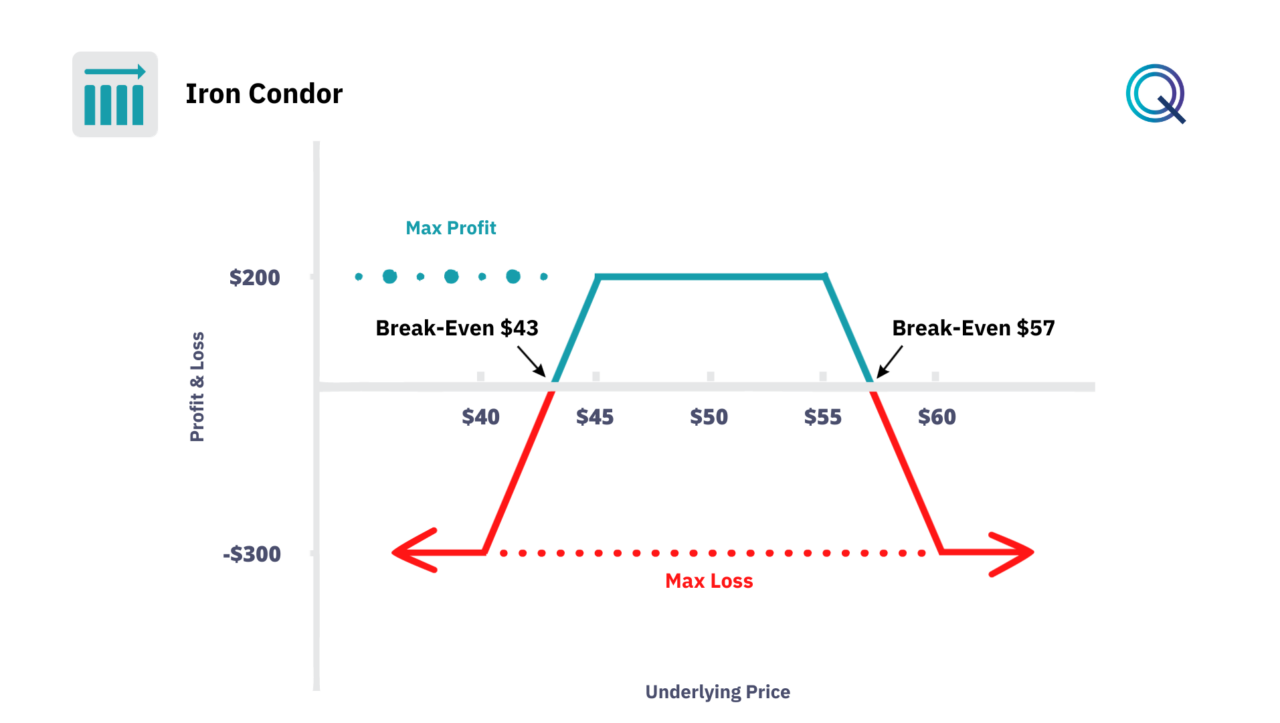Iron Condor

Among the “Market Neutral” strategies, we find the Iron Condor Strategy. The Iron Condor strategy is part of a series of advanced options strategies. It is a neutral or Market Neutral strategy. This type of strategy aims to generate returns from the collapse of volatility and the passage of time. It is a strategy that allows us to define our risk and return.
It reaches maximum profit if the price of the underlying stays within the strikes, and the structure expires worthless at expiration. This strategy consists of buying and selling two calls and two puts with the same expiration date. In this strategy, we have four strike prices.
How to set up an Iron Condor
An Iron Condor can be created by executing trades for selling out-of-the-money options and buying out-of-the-money options.
For example, if a stock is quoting at $50, we can create an Iron Condor in this way:
- Long Put with a $40 strike
- Short Put with a $45 strike
- Short Call with a $55 strike
- Long Call with a $60 strike
The idea behind this strategy is to sell two options with strikes closer to the current price to collect the premium and buy two options with strikes further away to cap potential losses.
- It is a credit strategy as we collect a premium, which is represented by the difference between the premiums collected from selling options and those paid for buying.
- The trader has the flexibility to choose the distance of the strike prices from the current price, and based on the distance, they will have a different risk/reward profile. The wider the spread between the strikes of the short positions and the long ones, the greater the premium collected.
Payoff Diagram of the Iron Condor
Let’s look at the payoff of the Iron Condor Strategy. In this example, the stock is quoting at $50, and we execute four trades: we sell a put with a $45 strike and buy one with a $40 strike. On the other side, we sell a call with a $55 strike and buy one with a $60 strike. Let’s assume our net credit (the difference between the premiums collected and those paid) is $2.
We have a defined risk and return.
- The maximum profit is represented by the credit received. In this case, $200, which is $2 * 100 shares.
- The breakeven prices are calculated by adding and subtracting the credit received from the strikes of the short or selling positions. In this example, $43 and $57, which are $2 below the strike of the sold put and $2 above the strike of the sold call.
- The maximum loss is $300, which is the difference between the break-even prices and the strikes of the purchased options.

Variables to evaluate on the Iron Condor Strategy
In this strategy, we are short options. When we are short options, we must therefore evaluate the impact of the following variables:
- Strike Selection. Experienced traders carefully select strike prices based on the probability of success. They might use statistical data and modeling to determine the likelihood of the underlying asset staying within the bounds of the Iron Condor.
- Timing Entry and Exit. Timing is crucial. Traders might look to establish Iron Condors in periods of high volatility when premiums are more lucrative. On the other hand, exiting or adjusting the trade before expiration can be important if the market starts to move against the position.
- Economic Events. Traders monitor economic calendars to avoid setting up Iron Condors before potential high-impact events that could cause significant movement in the underlying asset.
- Technical Analysis. Technical indicators might inform the decision-making process, aiding in the prediction of price stability within the range of the Iron Condor.
- Risk Management. Setting maximum acceptable loss limits and desired profit targets can help traders manage their risk.
- Hedging Strategies. Some traders may employ hedging strategies to reduce risk, such as buying further out-of-the-money options or using futures contracts.
- Implied Volatility. If the implied volatility decreases, this will have a positive impact on the strategy as the premium will tend to decrease, which is positive for the seller. This strategy benefits from low volatility.
- Time Decay. The Theta factor is positive for this strategy because it decreases the value of the premiums of the sold options.
Once we have entered into a position, we can at any time close or modify our strategy. For example, we can close one leg of the position and open another with a different strike based on the price movement, or we can roll the entire Iron Condor.
We discuss this in detail in our Academy.
How to structure an Iron Condor
When setting up an Iron Condor we are not limited to combining only two option positions. We can combine the Put Credit Spread, which positions us for the market to stay above our level, and the Call Credit Spread, which positions us for the market to stay below our level.
By combining these two positions, we make money as long as the market trades within this range.

- In this example, we have a Put Credit Spread where we sold the $11 Put strike and bought the $10.5 Put Strike, combined with selling a $12 Call strike and buying the $12.5 Call strike.
- This establishes a credit position where we retain 100% of the credit if Ford price closes between $11 and $12 at the expiration date.
- We are risking $46 to potentially make $4 (8% return). Our breakeven points are $10.96 on the low side and $12.04 on the high side.
How to use Menthor Q Levels?
Looking back at this week’s Q Levels, how likely does it appear that Ford will remain above $11 this week? What about next week? First we can start by looking at the Net GEX Chart.

Keep in mind that you don’t have to enter both sides of an Iron Condor position at the same time. If you believe the market will make an initial down move, you might establish the Call Credit Spread first, and allow some value erosion in that position, then, when the market bounces off a significant Q-Level and begins to rise, establish your Put Credit Spread when it’s valued higher (because the current price is closer to the Put Credit Spread position), and let the value erode as the price continues to climb.
This might also be a good time to consider closing the Call Credit Spread, if the value of the position has provided the expected value.
How to manage an Iron Condor Strategy
There are plenty of ways to make money using these positions. If you are interested in Iron Condors we have a dedicated section of our Premium Membership that will guide you how to manage the trades. Try Premium Free.
You will find plenty of tips on entering the position and establishing your exit position within a $0.15 move on the position. It doesn’t take a lot of movement to make a good return. We also provide you access to our Model within our Daily Note. Join Now! It’s FREE.
Conclusion
To recap:
- The Iron Condor Strategy is a Market Neutral strategy.
- Our position is Short Options.
- It is a Credit structure.
- Both the maximum risk and the maximum profit are limited.
- The strategy benefits from a decrease in volatility.
- Time is a positive factor for this strategy.
Other Market Neutral Strategies
Here are other neutral strategies with Options:
